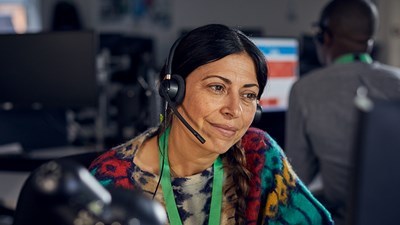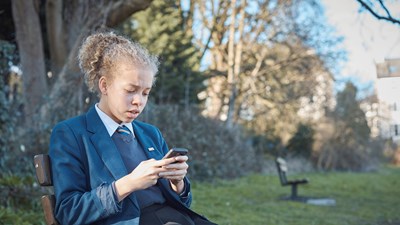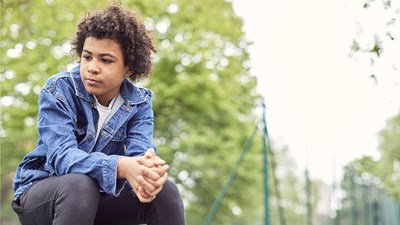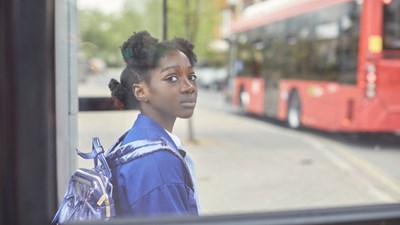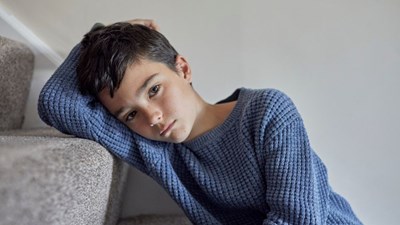Finding out your child has been groomed can be distressing and you might not know what to do next. We're here to support you and have advice to help you keep children and young people safe.
Worried about a child?
Contact our Helpline by calling 0808 800 5000 or emailing [email protected].
What is grooming?
Grooming is when someone builds a relationship, trust and emotional connection with a child or young person so they can manipulate, exploit and abuse them.
Children and young people who are groomed can be sexually abused, exploited or trafficked.
Anybody can be a groomer, no matter their age, gender or race. Grooming can take place over a short or long period of time – from weeks to years. Groomers may also build a relationship with the young person's family or friends to make them seem trustworthy or authoritative.
Types of grooming
Children and young people can be groomed online, in person or both – by a stranger or someone they know. This could be a family member, a friend or someone who has targeted them – like a teacher, faith group leader or sports coach.
When a child is groomed online, groomers may hide who they are by sending photos or videos of other people. Sometimes this'll be of someone younger than them to gain the trust of a "peer". They might target one child online or contact lots of children very quickly and wait for them to respond.
The relationship a groomer builds can take different forms. This could be:
- a romantic relationship
- as a mentor
- an authority figure
- a dominant and persistent figure.
A groomer can use the same sites, games and apps as young people, spending time learning about a young person's interests and use this to build a relationship with them. Children can be groomed online through:
- social media networks
- text messages and messaging apps, like Whatsapp
- text, voice and video chats in forums, games and apps.
Whether online or in person, groomers can use tactics like:
- pretending to be younger
- giving advice or showing understanding
- buying gifts
- giving attention
- taking them on trips, outings or holidays.
Groomers might also try and isolate children from their friends and family, making them feel dependent on them and giving the groomer power and control over them. They might use blackmail to make a child feel guilt and shame or introduce the idea of 'secrets' to control, frighten and intimidate.
It's important to remember that children and young people may not understand they've been groomed. They may have complicated feelings, like loyalty, admiration, love, as well as fear, distress and confusion.
Signs of grooming
It can be difficult to tell if a child is being groomed – the signs aren't always obvious and may be hidden. Older children might behave in a way that seems to be "normal" teenage behaviour, masking underlying problems.
Some of the signs you might see include:
- being very secretive about how they're spending their time, including when online
- having an older boyfriend or girlfriend
- having money or new things like clothes and mobile phones that they can't or won't explain
- underage drinking or drug taking
- spending more or less time online or on their devices
- being upset, withdrawn or distressed
- sexualised behaviour, language or an understanding of sex that's not appropriate for their age
- spending more time away from home or going missing for periods of time.
A child is unlikely to know they've been groomed. They might be worried or confused and less likely to speak to an adult they trust. If you're worried about a child and want to talk to them, we have advice on having difficult conversations.
Worried about a child?
You can contact the NSPCC Helpline by calling 0808 800 5000, emailing [email protected] or completing our report abuse online form.
If a child reveals abuse
If a child talks to you about grooming it's important to:
- listen carefully to what they're saying
- let them know they've done the right thing by telling you
- tell them it's not their fault
- say you'll take them seriously
- don't confront the alleged abuser
- explain what you'll do next
- report what the child has told you as soon as possible.
Effects of grooming
Grooming can have both short and long-term effects. The impact of grooming can last a lifetime, no matter whether it happened in person, online or both.
A child or young person might have difficulty sleeping, be anxious or struggle to concentrate or cope with school work. They may become withdrawn, uncommunicative and angry or upset.
Children, young people and adults may live with:
- anxiety and depression
- eating disorders
- post-traumatic stress
- difficulty coping with stress
- self-harm
- suicidal thoughts
- sexually transmitted infections
- pregnancy
- feelings of shame and guilt
- drug and alcohol problems
- relationship problems with family, friends and partners.
Our services can support children and young people who have experienced grooming to help them move on and receive the care they need.
Who's at risk
Any child is at risk of being groomed. And it's important to remember that both boys and girls can be groomed.
Children who are groomed online could be abused by someone they know. They could also be abused by someone who commits a one-off act or a stranger who builds a relationship with them.
Some children are more at risk of grooming, particularly those who are vulnerable. Children in care, with disabilities or who are neglected can be targeted by groomers. Groomers will exploit any vulnerability to increase the likelihood a child or young person will become dependent on them and less likely to speak out.
Report grooming
CEOP make reporting online grooming easy. Whether you're a parent, carer, worried adult or young person, you can make a CEOP report online.
You can also contact your local child protection services or the police to report your concerns about any type of grooming - whether it's happening online, in person or both.
It’s important to remember that it’s against the law to make or share images of child abuse. If you see a video or photo that shows a child being abused, don’t comment, like or share it. Instead, you can report it to:
- the website it’s on
- the police
- or contact us and we’ll report it to the police for you.
Worried about how to support a young person who has had a sexual image or video of themselves shared online? If they’re under 18, they can use Childline and the Internet Watch Foundation's discreet Report Remove tool to see if it can be taken down. Young people can get support from Childline throughout the process.
If you're worried county lines and criminal exploitation, you can take steps to keep children and young people safe.
- Call 999 if the child is at immediate risk or call 101 if you think a crime has been committed
- Call Crimestoppers anonymously on 0800 555 111 or online.
- Contact your local child protection services. You can find their contact details on the website for the local authority the child lives in.
Report abuse
You can contact the NSPCC Helpline by calling 0808 800 5000, emailing [email protected] or completing our report abuse online form.
Report Abuse in Education helpline
We’ve launched a dedicated helpline for children and young people who have experienced abuse at school, and for worried adults and professionals that need support and guidance, including for non-recent abuse. Call our new NSPCC helpine, Report Abuse in Education on 0800 136 663 or email [email protected].
Support
For parents and carers
Finding out your child has been groomed and exploited can be frightening and distressing. But there's help for you and your family.
PACE works with parents and carers of children who are, or at risk of, sexual exploitation. You can call them for confidential help and advice on 0113 240 5226 or fill in their online form.
Worried about a child?
You can contact the NSPCC Helpline by calling 0808 800 5000, emailing [email protected] or completing our report abuse online form.
For children and young people
We run therapeutic services for children who have experienced, or are at risk of, grooming:
- Hear and Now
- In Ctrl
- Letting the Future In
- Protect and Respect
Find out more about all our services for children, including how to get in touch with ones in your area.
How Childline can help
We understand how difficult it is for children to talk about grooming. Whether it's happening now or happened in the past, Childline can be contacted 24/7. Calls to 0800 1111 are free and confidential. Children can also contact Childline online.
Childline has information and advice for children and young people about online grooming and keeping safe online.
Prevent grooming
There are steps we can all take to keep children and young people safe from grooming.
Teaching children and young people about healthy relationships and how to stay safe online can help prevent sexual abuse and exploitation. These foundations can be laid from a young age. Our PANTS rules are a simple way to teach younger children how to stay safe from abuse. Your child may have already had the talks in school, but it’s important to talk to them at home too. We have tips and advice on how to have difficult conversations.
It's also important to make sure children and young people know there are trusted adults, including outside home that they can speak to about their worries, such as school or Childline.
You can ask your child's school to book a free Speak out Stay safe assembly for primary school children. Our specially trained staff and volunteers hold assemblies and workshops, covering topics like bullying and abuse, but without using any scary words or adult language.
If you're worried about gangs, it can be difficult to know what to do to help protect young people. Whether a child is thinking about joining a gang, is already involved or want to leave, they need help and support. You can contact our Helpline for details of organisations near you that can give you support and advice.
Encourage transparency in what your children are doing online. You can keep gaming devices and computers and laptops with webcams in the living room or family spaces. Use parental controls and keep up-to-date on the apps and games children and young people are using.
We know parents and carers of d/Deaf and disabled children and young people can worry about keeping their children safe from abuse. Some children and young people may not be aware of the dangers of abuse. Or aren't able to let someone know they're not safe because it may be harder for them to show or tell someone.
We have a range of guides you can download to help children learn the PANTS rules without using any scary words. You can look at these together and talk about what PANTS means. We've also got tips and advice to help you answer some of the common questions children and young people ask.
For d/Deaf children and young people we have a video in British Sign Language (BSL) with subtitles to help you share the PANTS rules. Our video on contacting Childline using SignVideo is a useful tool to help you explain different types of abuse and give children and young people the knowledge of who they can contact if they're worried.
Help if you're worried about your behaviour
If you're worried about your behaviour, help is available.
If you are, or think you might, sexually abuse a child or young person, there's help available. Stop it now! is a free helpline offering information, guidance and support.
- Call Stop it now! – People living in the UK and Ireland can call for free on 0808 1000 900 (Monday – Thursday 9am-9pm and Friday 9am-5pm).
- Message online – Stop it now! have a secure messaging service available24-hours a day.
If you're part of a gang there are support groups and specialist agencies like St Giles Trust, Safer London Foundation and One Big Community who can can help. Call us on 0808 800 5000, email [email protected] or fill in our online form for details of organisations near you.
You can call us for information and advice on 0808 800 5000, email [email protected] or fill in our online form.
